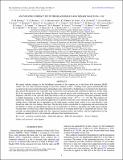AN EVOLVING COMPACT JET IN THE BLACK HOLE X-RAY BINARY MAXI J1836–194
Author(s)
Russell, D. M.; Russell, T. D.; Miller-Jones, J. C. A.; O'Brien, K.; Soria, R.; Sivakoff, G. R.; Slaven-Blair, T.; Lewis, F.; Markoff, Sera B.; Altamirano, D.; Curran, P. A.; Rupen, M. P.; Belloni, Tomaso M.; Cadolle Bel, M.; Casella, P.; Corbel, S.; Dhawan, V.; Fender, R. P.; Gallo, Elena; Gandhi, P.; Heinz, Sebastian; Körding, E. G.; Krimm, H. A.; Maitra, D.; Migliari, S.; Sarazin, C. L.; Shahbaz, T.; Tudose, V.; Homan, Jeroen; Remillard, Ronald A; ... Show more Show less
DownloadRussell-2013-AN EVOLVING COMPACT.pdf (493.9Kb)
PUBLISHER_POLICY
Publisher Policy
Article is made available in accordance with the publisher's policy and may be subject to US copyright law. Please refer to the publisher's site for terms of use.
Terms of use
Metadata
Show full item recordAbstract
We report striking changes in the broadband spectrum of the compact jet of the black hole transient MAXI J1836–194 over state transitions during its discovery outburst in 2011. A fading of the optical-infrared (IR) flux occurred as the source entered the hard-intermediate state, followed by a brightening as it returned to the hard state. The optical-IR spectrum was consistent with a power law from optically thin synchrotron emission, except when the X-ray spectrum was softest. By fitting the radio to optical spectra with a broken power law, we constrain the frequency and flux of the optically thick/thin break in the jet synchrotron spectrum. The break gradually shifted to higher frequencies as the source hardened at X-ray energies, from ~10[superscript 11] to ~4 × 10[superscript 13] Hz. The radiative jet luminosity integrated over the spectrum appeared to be greatest when the source entered the hard state during the outburst decay (although this is dependent on the high-energy cooling break, which is not seen directly), even though the radio flux was fading at the time. The physical process responsible for suppressing and reactivating the jet (neither of which are instantaneous but occur on timescales of weeks) is uncertain, but could arise from the varying inner accretion disk radius regulating the fraction of accreting matter that is channeled into the jet. This provides an unprecedented insight into the connection between inflow and outflow, and has implications for the conditions required for jets to be produced, and hence their launching process.
Date issued
2013-04Department
MIT Kavli Institute for Astrophysics and Space ResearchJournal
The Astrophysical Journal. Letters
Publisher
IOP Publishing
Citation
Russell, D. M., T. D. Russell, J. C. A. Miller-Jones, K. O’Brien, R. Soria, G. R. Sivakoff, T. Slaven-Blair, et al. “AN EVOLVING COMPACT JET IN THE BLACK HOLE X-RAY BINARY MAXI J1836–194.” The Astrophysical Journal 768, no. 2 (April 29, 2013): L35. © 2013 The American Astronomical Society
Version: Final published version
ISSN
2041-8205
2041-8213